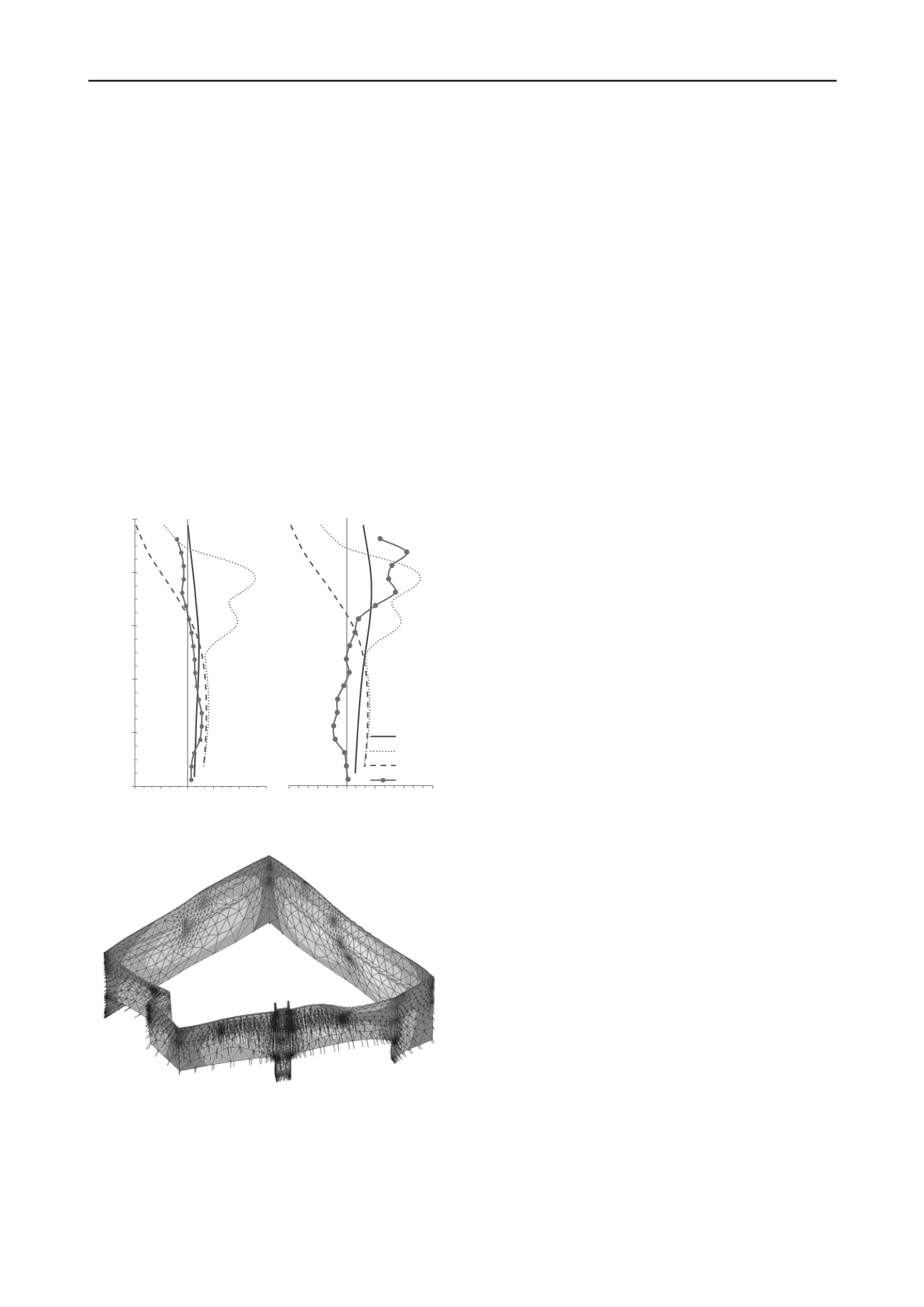
698
Proceedings of the 18
th
International Conference on Soil Mechanics and Geotechnical Engineering, Paris 2013
2.4
Comparison with Field Measurements
Figure 3 shows the computed and measured wall deflection
after the excavation of all zones was completed. The measured
wall deflection profiles were obtained from inclinometers
installed just behind the walls. The computed deflections are
taken from the sheet pile sections around the locations of the
inclinometers. As shown in Figure 3, the computed deflection
profile from plane strain analysis is too far off from the
measured profile, indicating its limitations for such geometries.
The deflection profile from axisymmetric analysis is somewhat
closer to the measured profile at section 2. However, the
monitoring team has concluded that the localized large
deflection at section 2 could be due to the presence of heavy
vehicles park beside the location of the inclinometer near that
section. Considering the uncertainties and complexities
involved in the actual construction as well as in the analysis, the
computed deflection profiles from 3D analysis and measured
deflection profiles are in reasonable agreement. The 3D analysis
(Figure 4) also shows that, that zone near section 2 is more
critical in terms of deflection and more attention is required. In
addition, the 3D analysis provides different deflection profiles
at different locations, such as corner effects, which is difficult to
achieve with simple idealizations.
-30 -15 0 15 30 45
Wall deflection (mm)
3DFEM
Axisymmetric
Plane Strain
Measurement
98
102
106
110
114
118
-30 -15 0 15 30 45
Reduced Level (m)
Wall deflection (mm)
Figure 3. Deflection profiles of sheet pile wall: (a) at section 1, and (b)
at section 2. Section 1 and 2 are as shown in Figure 1.
Figure 4. Deformed shape of the sheet pile wall with deflection vectors.
(Deformed shape is scaled to 200 times).
3 CONCLUSION
The latest developments in preconditioning has led to
significant improvement in computational times of iterative
solvers and open up exciting possibilities of conducting large-
scale 3D analyses on Desktop PCs. This will be helpful in
simulating complex geotechnical problems with strongly
varying material properties as simple idealizations may not be
sufficient in many cases.
4 ACKNOWLEDGEMENTS
The authors would like to acknowledge Dragages Singapore
(Pte) Ltd for providing the data related to studied project work.
The authors would also like to thank Dr. Hong Sze Han and
Zhang Guo-Qin of GeoSoft Pte Ltd for the help on creating the
mesh and for valuable discussions.
5 REFERENCES
Biot M.A. 1941. General theory of three-dimensional consolidation.
Journal of Applied Physics
12(2), 155-164.
Chan S.H., Phoon K.K., and Lee F.H. 2001. A modified Jacobi
preconditioner for solving ill-conditioned Biot's consolidation
equations using symmetric quasi-minimal residual method.
International Journal for Numerical and Analytical Methods in
Geomechanics
25(10), 1001-1025.
Chaudhary K.B., Phoon K.K., and Toh K.C. 2011. Inexact block
diagonal preconditioners to mitigate the effects of relative
differences in material stiffnesses.
International Journal of
Geomechanics
, doi: 10.1061/(ASCE)GM.1943-5622.0000197.
Chaudhary K.B., Phoon K.K., and Toh K.C. 2012. Effective block
diagonal preconditioners for Biot’s consolidation equations in
piled-raft foundations.
International Journal for Numerical and
Analytical Methods in Geomechanics
, DOI: 10.1002/nag.1127.
Chen X., Toh K.C., and Phoon K.K. 2006. A modified SSOR
preconditioner for sparse symmetric indefinite linear systems of
equations.
International Journal for Numerical Methods in
Engineering
65(6), 785-807.
Chen X. and Li L. 2011. Some issues in research on block
preconditioning for coupled Biot’s linear system.
Proc. Of 2nd
International Conference on Mechanic Automation and Control
Engineering, 15-17 July 2011
, Inner Mongolia, China, 2574-2577.
Cipra B.A. 2000. The best of the 20th century: Editors name top 10
algorithms.
SIAM News
33(4), 1-2.
Ferronato M., Gambolati G., and Teatini P. 2001. Ill-conditioning of
finite element poroelasticity equations.
International Journal of
Solids and Structures
38(34-35), 5995-6014.
Freund R.W. and Nachtigal N.M. 1994. A new Krylov-subspace method
for symmetric indefinite linear systems.
Proc. 14th MIACS World
Congress on Computational and Applied Mathematics
, Atlanta,
USA, 1253-1256.
(b)
(a)
Gambolati G., Ferronato M., and Janna C. 2011. Preconditioners in
computational geomechanics: A survey.
International Journal for
Numerical and Analytical Methods in Geomechanics
35, 980-996.
GeoFEA. 2012. Finite element software, version 9.0. GeoSoft Pte Ltd,
Singapore,
Lee F.H., Phoon K.K., Lim K.C., and Chan S.H. 2002. Performance of
Jacobi preconditioning in Krylov subspace solution of finite
element equations.
International Journal for Numerical and
Analytical Methods in Geomechanics
, 26(4), 341-372.
Lee F.H. 2005. Some issues in idealization in FE analysis.
Proc. of
Underground Singapore
, Singapore, 229-240.
Phoon K.K., Toh K.C., Chan S.H., and Lee F.H. 2002. An efficient
diagonal preconditioner for finite element solution of Biot’s
condolidation equations.
International Journal for Numerical
Methods in Engineering
55(4), 377-400.


